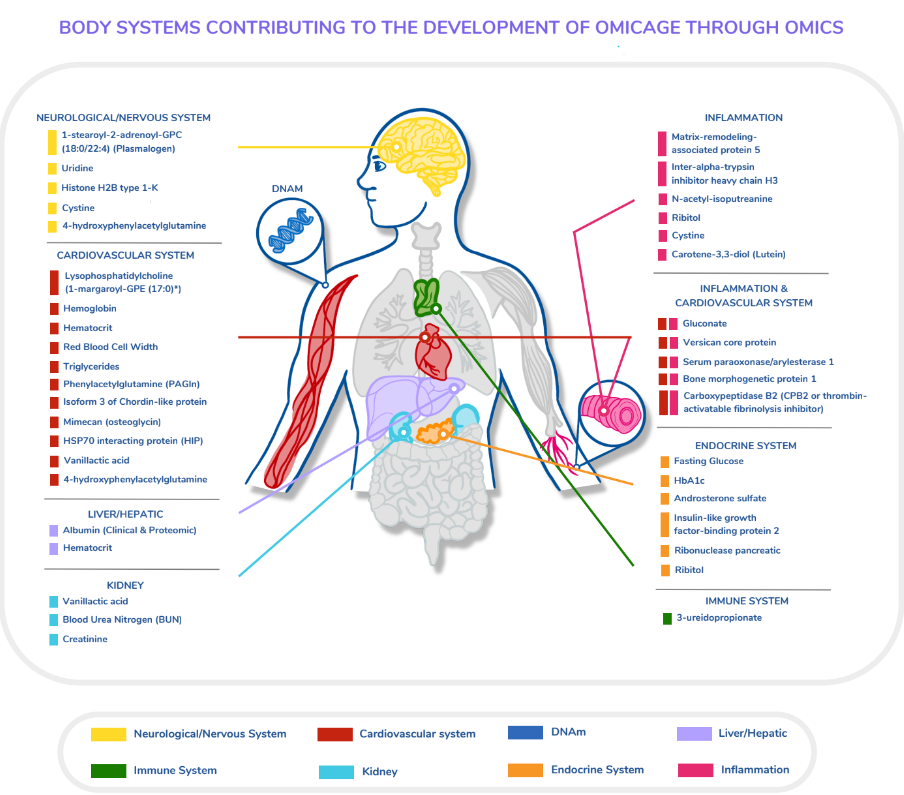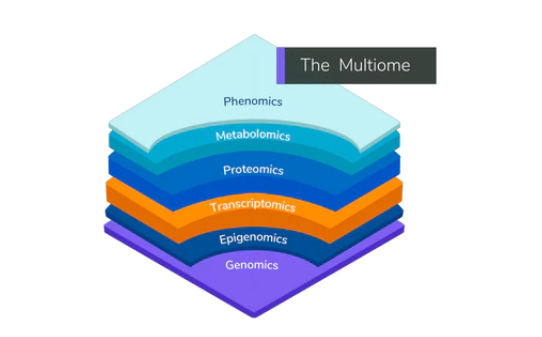MultiOMICm Age Algorithm
Accelerated aging represents the predominant risk factor for chronic and degenerative diseases.
Cellular aging requires an understanding of the biological processes linking aging with diseases. There are nine molecular biomarkers of aging termed “The Hallmarks of Aging.”
→ Genomic instability;
→ Telomere attrition:
→ Cellular senescence;
→ Altered intercellular communication;
→ Mitochondrial dysfunction;
→ Loss of proteostasis;
→ De-regulated nutrient-sensing;
→ Stem cell exhaustion;
→ Epigenetic alterations
Delving into each aging hallmark is beyond the scope of this article. The key is to understand that epigenetics is the interface between the environment and the human genome.
Your lifestyle choices determine the expression or suppression of genes – which impacts every facet of your life.
MultiOmics, or the Multiome, is a term used to describe the various layers of human biology, and how they interact.
As scientists strive to improve the precision and accuracy of biological age calculations via the development of new, age-calculating algorithms the importance of factoring each level becomes critical.
Viewing the physical and cognitive traits that impact your quality of life through the lens of multiomics allows for an in-depth, complete, and biological understanding of exactly what is causing those aging experiences.
When scientists program their mathematical algorithms with multi-omic data, biological age predictions are more accurate and actionable for both patients and their healthcare providers.
Aging is a molecular, biological process that is eventually visible through physical and cognitive traits of deterioration that impact your health and quality of life.
From the DNA inside the nucleus of your cells to the gray hair on your head the biological journey of aging has several complex stops on its journey.
The following biological elements and processes create the Multiome, with each layer affected by its predecessor until the trait that was coded in your DNA is finally observable.

The Multiome is the culmination of the following cellular processes:
→ Genomics
The study of the genes housed in our DNA sequence. DNA is located in the nucleus of our cells. It contains sections of instructions [genes] that convey how a cell ought to behave. Your DNA blueprint is absolute and cannot be altered. Your DNA sequence is fixed from birth to death.
Genomics is an interdisciplinary field of biology focusing on the structure, function, evolution, mapping, and editing of genomes. A genome is an organism’s complete set of DNA, including all of its genes as well as its hierarchical, three-dimensional structural configuration.
→ Epigenomics
Epigenomics is the study of the complete set of epigenetic modifications on the genetic material of a cell, known as the epigenome. The field is analogous to genomics and proteomics – which represent the study of the genome and proteome of a cell.
The study of how genes are modified. Epigenetic biomarkers interact with our DNA via gene expression or suppression. The interactions are constant throughout your lifetime.
→ Transcriptomics
The study of how our genes become actionable RNA [Ribonucleic acid]. Ribonucleic acid (RNA) is a molecule that is present in the majority of living organisms and viruses. It is made up of nucleotides, which are ribose sugars attached to nitrogenous bases and phosphate groups. The nitrogenous bases include adenine, guanine, uracil, and cytosine.
Transcriptomics technology is the technique used to study an organism’s transcriptome – the sum of all of its RNA transcripts. The information content of an organism is recorded in the DNA of its genome and expressed through transcription.
→ Proteomics
Proteomics is the study of the interactions, function, composition, and structures of proteins and their cellular activities. Proteomics provides a better understanding of the structure and function of the organism than genomics. Proteins are coded by RNA and perform the work within the cell. Antibodies, enzymes, and hormones represent types of protein function.
Proteomics is the large-scale study of proteins. Proteins are vital parts of living organisms, with many functions such as the formation of structural fibers of muscle tissue, enzymatic digestion of food, or synthesis and replication of DNA.
→ Metabolomics
Metabolomics is the scientific study of chemical processes involving metabolites, the small molecule substrates, intermediates, and products of cell metabolism.
The study of the chemical processes produced by protein interactions. Metabolites represent a by-product of the ceaseless hard work of proteins to break down food, drugs, chemicals, or bodily tissue.
→Phenomics
The study of the phenotype. Phenotype refers to an individual’s observable traits, such as height, eye color, and blood type. The phenotype is determined by both their genomic makeup [genotype] and environmental factors
Epigenetics curates these instructions and their impact on your biological expression is orchestrated by proteins and metabolites.

Previous DNA methylation clocks have estimated the degree of aging in an individual, but they have not been able to explain why someone might have accelerated or decelerated aging outcomes.
Your biological age can be summarized as a calculation of the toll that life has taken on your body. The temperature has degrees, weight has kilograms, and distance has meters, but a singular unit of measurement to define biological age does not exist.
To quantify the “biological toll” scientists must be able to:
→ link age to different biological patterns that can already be directly measured, and
→ develop a mathematical equation [known as an algorithm or clock] that examines, filters, and weighs various age-related measurements to determine the biological age of your body.
Genetics, epigenetics, cellular transcriptions, proteins, and metabolites play a role in the aging process. These elements complicate the scientific ability to identify a single biomarker that determines biological age. It is crucial to examine the interconnectedness of seemingly disparate biological markers.
OMICm Age is the newest epigenetic biological age clock created by researchers at TruDiagnostic™ and Harvard University. It uses some of the most comprehensive aging data ever collected in a single cohort to predict the age of your body through advanced epigenetic methylation algorithms.
The OMICm Age algorithm can establish correlations between proteins, metabolites, and other clinical measurements with quantifiable methylation patterns.

By incorporating these newly established connections into their algorithm, the OMICm Age clock can deliver the most accurate results currently available in the epigenetic, scientific community. Aging is a complex process that is influenced by multiple factors.
“Therefore, we built a robust aging cohort that had available clinical data and combined this with measures of proteins, metabolites, and epigenetics for each individual,” explains Dr. Jessica Lasky-Su of Brigham and Women’s Hospital.
The OMICm Age clock was able to predict death with 87% accuracy over 10 years in their aging cohort [study group]; outperforming other current methylation clocks and chronological age.
Another development stemming from the OMICm Age study was the creation of methylation algorithms that quantify other important clinical biomarkers. Epigenetic methylation data created predictors of proteins, metabolites, and clinical values by channeling aging factors into a single diagnostic.
Age is the predominant risk factor for almost all chronic diseases and death. The unique biology of aging can be different among people who share the same birth year.
Lasky-Su stated the OMICm Age algorithm improves our ability to identify major risk factors for age-related diseases and a precise understanding of what factors and biological processes contribute to the current biological age of an individual.
It is clear we see some individuals in their 70s who look 50 years of age, and vice versa; highlighting the need for a better way to measure bodily aging.
This is why the concept of biological age was created and the potent value of its distinction.
Chronological age simply is not a reflective metric of the underlying, biological differences in aging. OMICm Age demonstrated a more incisive method to demonstrate our death prediction models.
Learn more about how to transcend your health, performance, and longevity in life and sport at Performance Medicine™.

__________________
About TruDiagnostic™ | The Epigenetic Company
Home to the largest, private DNA methylation database in the world, TruDiagnostic™ is a leading health data company and CLIA-certified laboratory that specializes in epigenetic testing and research. In partnership with notable biotech developers, researchers, and academic institutions, we are transforming the healthcare potential of epigenetic data into actionable applications.
We aim to improve people’s lives by arming patients and physicians with novel biological insights; enabling them to make the right lifestyle and medical decisions through information found in the fluid epigenome. With the ability to analyze more than 1,000,000 locations on one’s DNA, our TruAge™ biological aging tests provide the most in-depth results, and multi-omic correlations to accelerated aging.
Emilie Arroyo, Media Relations
(786) 247-4579
emilie@trudiagnostic.com
www.trudiagnostic.com
| Additional Contacts | |
| Hannah Went, Director of Operations | General Inquiries |
| (937) 570-0471 | (833) 963-1700 |
| hannah@trudiagnostic.com | support@trudiagnostic.com |
| www.trudiagnostic.com | |



